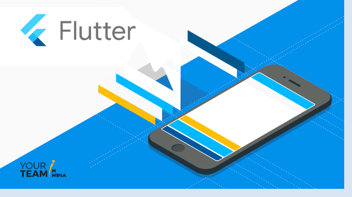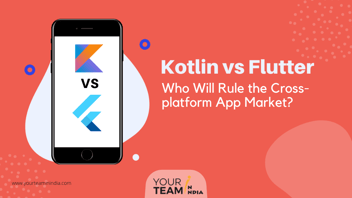Quick Summary: Flutter is an open-source UI toolkit that stands out as a top choice for enterprises looking to enhance their app development projects. Let's explore the compelling reasons that Flutter is the leading framework for creating powerful and seamless enterprise applications.
Introduction
The landscape of application development has transformed significantly with the emergence of Flutter. This platform has simplified the once complex and time-consuming app development process.
Customized widgets, a single codebase, aesthetically pleasing UI elements, layered architecture, and everything else have contributed to a seamless, unifying app development process with Flutter.
Not only this, but Flutter has also gained attention in enterprise app development.
Key Takeaways
- Choosing Flutter app development for enterprise means utilizing a powerful framework that combines speed, flexibility, and aesthetics to deliver outstanding user experiences and drive business success.
- Developing an enterprise app with Flutter provides an efficient and flexible solution for businesses that need a robust, cross-platform application development framework.
- Different enterprises use Flutter for its deep expertise, high performance, and exceptional user interface design potential.
But what factors have led to its increased demand? How does it meet the requirements of enterprise app development, and why has it become a popular cross-platform framework among developers? Read on to discover the answers to these questions.
Growing preference of enterprises for app development with Flutter
Flutter is a cross-platform, open-source UI software development toolkit created by Google. It provides a versatile codebase for platforms such as Android, iOS, Windows, Google Fuchsia, Mac, and the World Wide Web. Flutter apps are coded in Google's object-oriented language called Dart, which offers benefits such as increased productivity and robustness for object-oriented application development.
The growing popularity of the Flutter framework is evident in the development community. According to a recent survey by Statista, 46% of developers prefer Flutter, making it the most popular cross-platform mobile framework.
As of 2023, an astonishing 2 million developers have embraced the framework's features and advantages. However, to take your business to the next level, all you need is to hire a Flutter developer who is not only proficient but also reliable.
What makes Flutter a Good Fit for Developing Enterprise Apps?
Every app development platform has some standout features that make it different from the rest. There are innumerable features of Flutter for enterprise apps; some of the essential elements are mentioned below:
Business Logic Components (BLoC)
The functioning of Flutter is majorly dependent on reactive programming that sometimes goes for streams. This architecture pattern is commonly known as BLoC (Business Logic Components). The benefit of this architecture is that it permits the separation of the app's UI from business logic by utilization of the stream.
The primary benefit of BLoC design is its responsiveness and separation of the user interface from the data. In contrast to other architectural patterns where the UI may be piled with delays, the BLoC architecture uses organized, async approaches and streams to prevent delays in the application's performance. It suggests that animations and screen scrolling will perform smoothly when data is stacked from the server.
For many years, we have used BLoC pattern architecture. It is best suited for applications with complicated architecture and a large amount of data. When the app's architecture is simple, the Provider design is used to simplify resource allocation and boost scalability for classes.
Code Architecture
The number of settled objects in Flutter programming does not affect the final display or responsiveness. This is because there are no recursive calls when constructing the layout.
For example, if many gadgets are included in the native app, the application's performance will likely suffer. In any event, Flutter allows you to carry out UI/UX ideas of any complexity, stylize them, and integrate many widgets.
Flutter enables multithreading, and threads are referred to as Isolates. When learning Dart, just one crucial Isolate is called the UI Thread. It is the ideal solution for long-running tasks that must be completed alongside the seamless operation of the entire program.
DartPub
Because Flutter is written in the Dart programming language, mobile developers typically use the DartPub as a package manager because it has multiple reusable packages and libraries. When selecting a plugin module, one may check its popularity and the code's health and upkeep.
It is critical when generating custom highlights - choosing modules based on popularity is not as essential as ensuring that the code is regularly renewed and tested. The actual module may not be generally recognized, but if you have some new programming features, it is possible to identify them based on the code's wellness.
These three are the main features/principles of Flutter for enterprise app development. We now understand what makes Flutter the perfect choice for enterprise apps. Let's move on to the next section to understand why businesses should use Flutter for Enterprise apps.
Why use Flutter for enterprise app development?
One of the main reasons Flutter is so popular is that it is a Google-backed open-source hybrid app development framework that seamlessly supports C, C++, and Dart programming languages. Additionally, the ability to build enterprise apps with a native-like appearance increases Flutter's visibility in the market. Wondering why Flutter is popular for developing the enterprise's app development? Find out the reasons below:
Fast MVP development
Flutter for MVP development is an outstanding choice due to its unique set of features, which enhance the developer's productivity.
Since the widgets in Flutter are immutable, only the screens are actively worked on and undergo the reload process. This approach could reduce the app development time through Flutter by 30%.
Proven Efficiency
Enterprise apps follow a layered architecture of connected internal levels. These levels include the implementation of the presentation, service, business logic, and data access layers.
The architecture layer is as mentioned below:
There are certain limitations & requirements that developers must keep in mind while developing the layered architecture layer, as mentioned below;
- Better accessibility to robust app design and development.
- Business-wide team collaboration and communication.
- Easy to understand documentation of the code.
- Better app features.
Through these developmental requirements, Flutter allows developers to build secure networking to web resources, storage systems such as SQL databases, and library plugins that provide better hardware accessibility in the following manner:
- Easy State Management: This is the soul of Flutter, as it interacts with several open-source state management technologies, such as BLoC, Redux, setState, and so on.
- Code Independence: Dependency injection is required to free your code from multiple native platform processing. It's easy to do in Flutter using GetIT Locator. This DI library maintains layer separation with a state management framework.
- JSON Serialization and Deserialization for improved RESTful client and business app efficiency and usability.
- SQLite is used to store and process large structured databases.
- Flutter provides minimal local storage to hold keys and values, allowing the business app to continue functioning even after processing external databases.
Supportive development environment for Native Apps
To provide a native-like experience in cross-platforms, Flutter provides great agility in integrating apps with Android Studio, IntelliJ, and Visual Studio Code. These IDEs support the available computation device type to meet the iOS build requirements.
Aside from that, Flutter provides developers with a comprehensive collection of libraries to help with app creation and maintenance.
Let's look at how:
Flutter for enterprise apps offers a Dart environment, which allows apps to scale quickly. All you have to do is import Dart Packages (with Extended Libraries) to increase the supportability and functionality of the Flutter app. Dart Packages even allows you to refactor programs so that they may run on another platform, such as the cloud.
Proven Testability: Flutter for enterprise apps is well-compatible with three test units: unit tests, widget tests, and integration tests.
Flutter, as a cross-platform framework, can compile Android and iOS tool sets and combine native Android and iOS toolsets with enterprise CI/CD configuration to launch mobile apps to Google Play.
The User Interface
The user interface is critical to the success of your project after selecting and finalizing the app architecture. For this purpose, Flutter supports Cupertino Widgets for iOS and Material Widgets for Android OS.
You may use Flutter to incorporate the following design characteristics to keep your enterprise app user's attention:
- UI/UX designers can use Flare in Flutter, a 2D vector animation, to demonstrate animations.
- Endless Scrolling: In many programs, such as Facebook, Instagram, and Twitter, you can use infinite scrolling to explore the material on every scroll. You can do the same with Flutter.
- Page Transition: The page transition needs to vary depending on the action and requirements. However, you may utilize this page transition package as a library to meet your transition needs.
Not only that, but it has expanded significantly with today's vast Flutter library base and open-source dev community. This allows for picture caching for quicker loading, app speed, neuromorphic view, calendar view, timelines, and much more. You only need to utilize their bespoke packages as library codes.
Hardware Needed for Better Processing
Whatever features your program has must eventually execute on your hardware—your mobile device. As a result, a feature-rich program without sufficient hardware optimization is useless. You won't find any program in the market that works flawlessly without hardware optimization.
In this case, hardware optimization refers to mobile applications that access device hardware to execute hardware-specific activities. For example, suppose you use Amazon, a shopping app. In that case, it will ask permission to access your device's various functionalities, such as a microphone and location, to provide you with the desired user experience.
The permissions asked for various hardware usage vary depending on the application and use case; however, the following are the usual hardware access permissions that a standard mobile app can have that can be obtained using Flutter:
- Location
- Cameras
- Contacts
- Biometric identification
- Storage: Media and files
- Accelerometer, Speaker, and Microphone
- Gyroscope
Higher stability
Some projects in particular areas like healthcare, finance, eCommerce, and more require higher stability. Flutter offers that desired stability by compiling the code into CPU-specific Arm code and using its own rendering engines.
As a result, Flutter applications maintain a consistent interface even after operating system updates or system personalizations and ensure version compatibility as well.
Cross-platform support
One critical reason for choosing the Flutter framework is its cross-platform support. It uses the Dart programming language, which enables you to use the same code for both Android and iOS platforms.
Consequently, developers do not have to maintain a different codebase for different platforms or make even minor changes to the codes when creating them for different platforms.
Along with access to custom widgets and a single codebase, the developer has control over modifying and determining the appearance and performance of the application.
Faster time to market
A survey states that an average of almost 1642 new applications are released daily on Google Play. This certainly indicates how crucial it is to launch and release your app quickly.
This is where the app development with Flutter comes into the picture.
Flutter provides quick app release and quicker time to market to the apps that require rapid development. However, all you need is access to the Flutter developers with the required skills and expertise.
Decreased maintenance cost
Flutter is a cross-platform that allows developers to utilize the same codebase for every platform, saving testing and maintenance time as businesses do not have to invest separately in different platforms.
Since the requirement to write code for the other platforms from scratch eliminates development, developers have to spend less time, leading to a decrease in development costs.
Shorter testing process
Different technologies require different development processes that might be time-consuming and require more resources and investments. However, the case with Flutter is different.
Developers can make modifications instantly using a shareable codebase only by using Flutter. This leads to a simplified yet minimized testing process, allowing you to focus on other development stages.
Consistent user experience
Flutter's framework ensures a consistent user experience across various platforms, enabling enterprises to maintain brand consistency and deliver a seamless user journey, thereby enhancing customer satisfaction and loyalty.
Outstanding Flutter Mobile App Security
These days data is imperative to access a specific domain. And you don't want it to get into the hands of someone with bad intentions.
Compliances
Recognizing the value of digital users' intellectual property, all worldwide industries and governments have established online regulatory agencies that require app developers to adhere to Internet cybersecurity standards. HIPAA and HITECH standards for Healthcare corporate applications, PCI-DSS standards.
The governing agencies for internet security shift with geographies and countries. As a result, you must verify for and comply with relevant regulatory standards while designing any industry-specific enterprise application.
Enterprise app development and Flutter go hand in hand. While you have several choices for your next project, Flutter is the game changer for cross-platform app development.
Enterprise application development using Flutter use cases
Flutter empowers enterprises with several technical and user-oriented features to make apps more scalable and market-friendly. Some standard functionalities that Flutter enables in app development are creative animation, better app performance, allowing the app to screen pixels, and much more.
That is why several top platforms have selected application development using Flutter. Some of them include:
Google Pay
Everyone has heard of the popular e-wallet app 'Google Pay.' But did you know that the app is developed using Flutter only?
Yes, that is why many businesses prefer Flutter for enterprise applications.
Dream 11
Dream 11 is a fantasy sports app that was also developed using Flutter. The application successfully handles the humongous traffic of more than 50 billion users on a daily basis, which is a perfect example of enterprises choosing the platform for their app development.
Alibaba
This brand used Flutter to develop a Xianyu app, a cloud-based goods e-commerce platform, to help ease the development process.
Is Flutter the Real Game Changer of Cross-platform App Development?
The entire blog explains how Flutter helps build cross-platform apps that run for Android and iOS mobile apps. But to your surprise, Flutter has been expanding from native app development to cross-platform development for Web, Windows, and macOS.
But why cross-platform app development? One app code file would be compiled to run on all the available OS platforms. This is what developers need, right?
As a leading Flutter app development company with extensive experience, we are sharing a quick note on why Flutter is a beneficial choice for cross-platform development;
- You get access to numerous custom packages for faster code development that can be used as Dart code libraries for reduced time to market.
- Code resemblance of the native app.
- Flutter for app development also utilizes Skia, which is built with C++ to build 2D widgets.
- Zero business risk exposure with well-built apps.
- Helps build beautiful apps from a single code.
- The development process becomes easier and faster.
In the end, the open-source Flutter community works astonishingly well in developing custom Flutter packages and libraries for better cross-platform development support.
We have covered all the essential information you need for your next Flutter app development project.
Bottom Line
The use of Flutter in enterprise-grade app development is quickly gaining popularity. By embracing Flutter, enterprises can accelerate their time to market, streamline their development process, deliver exceptional user experiences, and reduce application development costs, driving business growth and success.
However, it is crucial to analyze the specific business requirements and then move further with the app development process with Flutter. Have questions about this? Connect with a Flutter development expert and transform your idea into a successful app development.

Frequently Asked Questions (FAQs)
Why should I develop enterprise apps using Flutter?
Flutter is perfect for developing complex enterprise applications. It is a cross-development platform that simplifies the development process by enabling quick app development with lower costs, shorter development cycles, higher stability and performance, a wide collection of pre-built widgets, unique UI elements, and more.
Can large-scale enterprise applications use Flutter?
Absolutely. Due to its layered architecture and higher performance, it is suitable for developing complex enterprise applications. With Flutter app development, enterprises can expect higher security, enhanced user interface, faster time to market, and higher stability in their applications.
Can Flutter be integrated with current backend systems?
Yes, through APIs and platform-specific plugins, Flutter supports seamless integrations with the existing backend systems. It can be integrated with any backend service your enterprise app requires, including databases and servers.
How Much Does Flutter Cost for Enterprise App Development?
The cost to make a Flutter app for an enterprise can vary due to several factors, such as the project complexity, the location of the Flutter developer, and even the Flutter app developer's experience. Therefore, a clear project definition with a well-defined project scope must be shared before deciding on the cost of creating an enterprise app using Flutter. Connect with YTII experts to get a quote for your enterprise app development using Flutter.
What is the future of Flutter in mobile app development?
Flutter is an app development platform that is gaining popularity with the support of the Google community. It enables developers to write code once and create cross-platform apps with a native-like experience. This is beneficial for both companies and developers. Therefore, Flutter is a promising platform for mobile app development.









